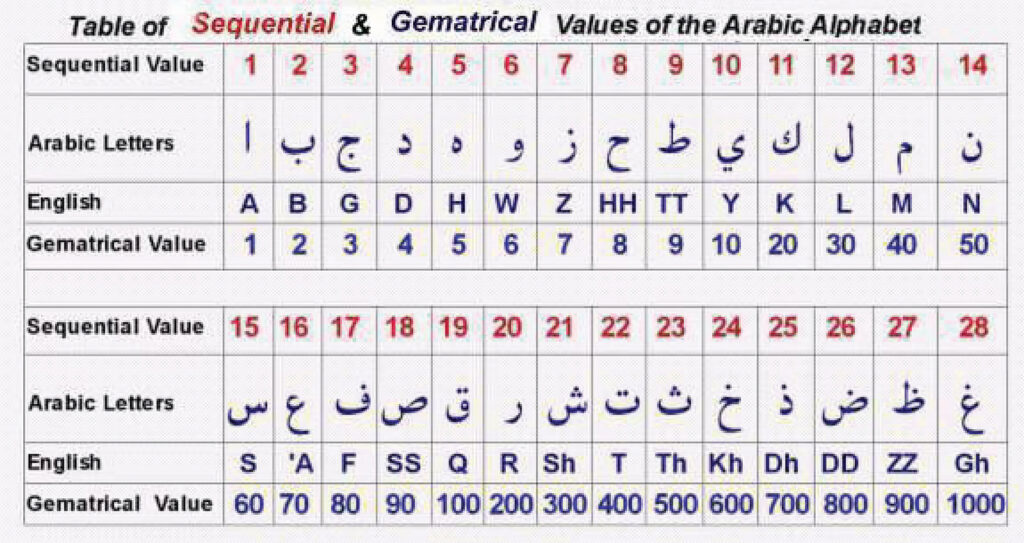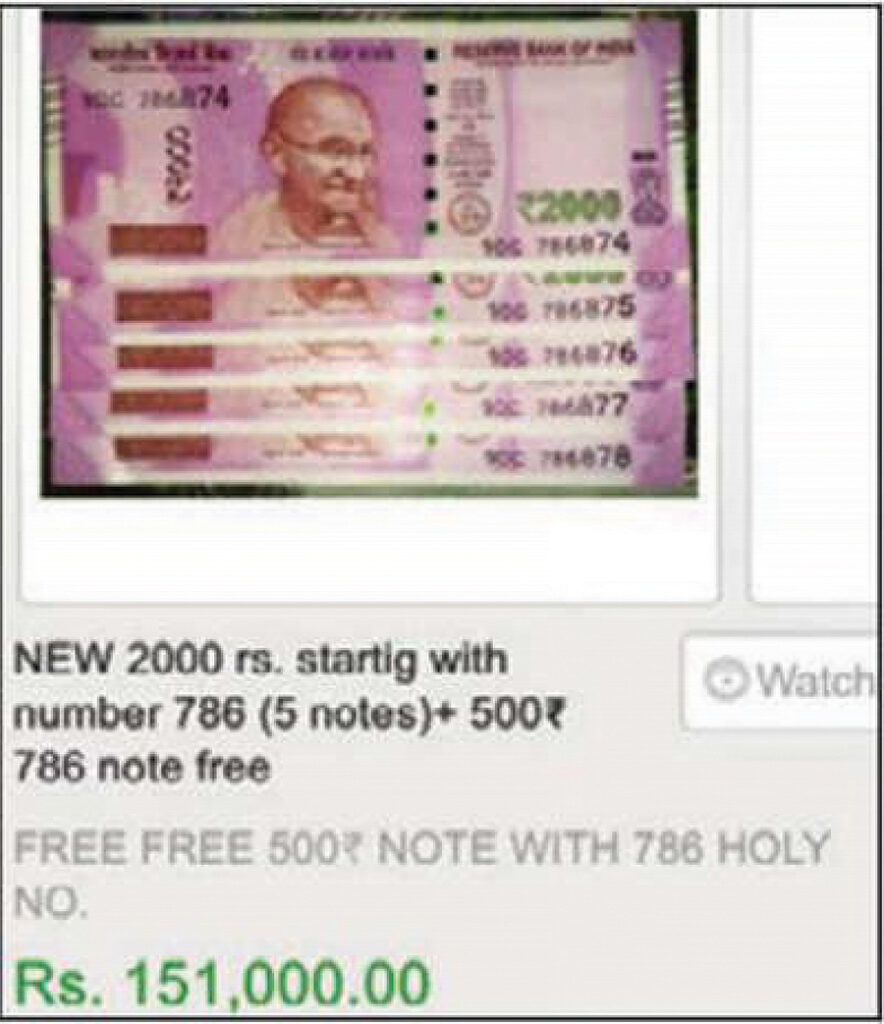Does Islam Sanction the Use of Numbers in Lieu of Bismallah?
By Misbahuddin Mirza
May/Jun 2024

For the average Joe, the numbers 786 may remind him of an area code in Florida’s Miami-Dade County. However, when many South Asian Muslims hear or see these numbers, they react quite differently — with a kind of veneration and feeling of spiritual significance.
For instance, the license plate number Z 786 fetched 1.035 million UAE dirhams ($280,000) during Dubai’s Roads and Transport Authority 2022 auction of “Distinctive Vehicle Number Plates” (Gulf Insider, Dec. 19, 2022). During 2017 in Pakistan, the license plate number 786 was purchased for 0.23 million rupees ($800; www.gari.pk/news). In India the previous year, a ₹2,000 rupee bill whose serial number started with 786 was offered on eBay for ₹150,000. Later eBay disabled access to this and similar offerings on their platform after the Times of India inquired about it. However, a market still exists on the internet for currency notes with different serial numbers ending in 786.
In 2017 a young Chicago couple, armed with a Philippine Muslim organization’s halal certificate, launched a cosmetic line using 786 as their brand name. Some South Asian Muslims commonly start their written correspondence with 786 instead of the traditional bismallah: “In the name of Allah, Most Gracious, Most Merciful.” In addition, numerous Indian movies have been made around this “important” number as well.
Islamic scholars agree that 786 has no significance in Islam and strongly discourage this widespread practice. Sheikh Muhammed Salih Al-Munajjid (founder, islamqa.info) says: “The number 786 means 786 and nothing more. When Allah or His messenger want to teach us something, they do so in the clearest way, far from puzzles and mystery numbers. All the efforts made by some Muslims to count letters and relate them to numbers are nothing but a waste of time.” Shaykh Gibril Fouad Haddad, an influential Islamic scholar and author, calls this practice a reprehensible innovation (Islamqa.org).
So, what is the origin of this practice and how did it creep into Muslim society? The number 786 is based on the Arabic abjad system, which is itself based on numerology, an ancient cultic system that assigns a numeric value to each letter in a given alphabet. The earliest recorded methodical system of numerology is found among the Pythagoreans, a school developed by the Greek philosopher and polymath Pythagoras in the 6th century bce. Very little is known about this Greek philosopher and polymath, and it’s uncertain if he actually discovered the geometric Pythagorean theorem.
Numerology in General
The earliest recorded methodical system of numerology is found among the Pythagoreans, a school developed by the Greek philosopher and polymath in the 6th century BCE. Very little is known about this Greek philosopher and polymath, and it’s uncertain if he actually discovered the geometric Pythagorean theorem.
Brittanica.com states: “The Pythagoreans invested specific numbers with mystical properties. The number 1 symbolized unity and the origin of all things, since all other numbers can be created from 1 by adding enough copies of it. For example, 7=1+1+1+1+1+1+1. The number 2 was symbolic of the female principle, 3 of the male; they come together in 2+3=5 as marriage. All even numbers were female, all odd numbers male. The number 4 represented justice. The most perfect number was 10, because 10=1+2+3+4. This number symbolized unity arising from multiplicity. Moreover, it was related to space. A single point corresponds to 1, a line to 2 (because a line has two extremities), a triangle to 3, and space to 4. Thus 10 also symbolized all possible spaces.”
Islamway’s webpage on Angelfire.com (https://www.angelfire.com/hi/islamway/786.html) quotes the following explanation from Arafaque Malik’s article in The Straight Path magazine’s May/June 1999 issue: “This gave birth to the science of Gematria. The Qabalist gematria is based on the combination of magic and philosophy which centered on twenty-two letters of the Hebrew scripture and its corresponding numbers to discover hidden meaning in the scripture of interchanging Hebrew words whose letters have the same numerical value when added. The science of Gematria was borrowed by some Muslim theological adventurers who called it ABJAD. Thomas Patrick Hughes, in his Dictionary of Islam (W.H. Allen & Co., London, 1885), explains ABJAD as ‘the name of an arithmetical arrangement of the alphabet, the letters of which have different powers from one to one thousand. It is in the order of the alphabet as used by the Jews … then six remaining letters being added by the Arabians.’”
Ibrahim Ahmed summarizes Frank Lewis’ (Emory University) essay on this system on submission.org: “There are two principal variations in the Abjad system as to the value of certain letters; the Arabs of North Africa and Spain gave a different alpha-numeric order to some of the letters in the 100s than was common in the Levant and the Islamic east. However, this variation does not affect the values of letters under 100, which have always and everywhere been the same, so far as I know. The Abjad values and their mnemonic groupings are as follows. Short vowels have no value (except in the beginning of a word, where they are necessarily accompanied by alif/hamza). Note that hamza (‘) and `ayn (`) are different letters with different values, as are the letters followed by dots (which would be under dots in printed versions of texts rendered in accord with the romanization system used by Shoghi Effendi for Baha’i texts).”

“In the Maghrib (Spain and North Africa), the following variant values obtained, to wit: s.=60, d.=90, s=300, z.=800, gh=900, sh=1000. N.B.: Certain phonemes which require two letters to represent in the roman alphabet (e.g., Th, Kh, Dh, Gh, Sh) are each rendered by a unique letter in the Arabic alphabet. Likewise, doubled consonants (hurúf mushaddada) are counted only once. For example, though in transliteration we write Muhammad, in the Arabic script, the doubled consonant ‘mm’ is represented by a diacritical mark (tashdid) over a single ‘m’, which is therefore only written once and only counted once. Hence the numerical values of Muhammad and Nabíl are identical (remember not to count the short vowels, which are any vowels in transliteration which lack the accent mark): M+h.+mma+d=40+8+40+4=92, N+b+i/y+l=50+2+10+30=92.”
Wikipedia compares this system to other numerology systems: “The Abjad numerals are equivalent to the earlier Hebrew numerals up to 400 … known as Gematria and are used in Kabbalistic texts and numerology. Like the Abjad order, it is used in modern times for numbering outlines and points of information, including the first six days of the week. The Greek numerals differ in a number of ways … In modern times the old 27-letter alphabet of this system also continues to be used for numbering lists.”
If the above was not confusing enough, four additional Farsi words were later added to the mix as this cultic practice moved eastward:
Arafaque Malik summarizes, “Having borrowed the Qabalist science of gematria, the Muslim theological adventurers, who had nothing else to do, got down to reducing the Qur’anic verses and eventually the Surahs to numbers. The most commonly used number is 786, which is normally found on letterheads, the beginning of books, pamphlets, letters etc. We are made to believe that 786 stands for ‘Bismillah irRahman irRaheem’ (In the name of Allah, the Most Gracious, the Most Merciful) … It is my contention that 786 does not mean ‘Bismillah irRahman irRaheem’ but merely seven hundred and eighty-six.”
Now back to Islam’s position on this cultic practice. The website https://aboutislam.net explains how pervasive and prevalent this abhorrent practice has become in parts of our society: “Islamic numerology has traditionally been used to access information from the unseen world, most notably future events. For example, it is still common today in some Islamic cultures for potential in-laws to analyze the numerical values associated with the letters of a man and woman’s names to see if the couple will make a suitable match.” The Merriam Webster dictionary defines numerology as “the study of the occult significance of numbers.” Islam’s stand on occult practices is explicitly clear: “Whoever approaches an oracle or a fortune-teller has disbelieved in what was revealed to Muhammad” (“Sunan Abi Dawud,” vol.3, p.1095, no.3895). In other words, such a person falls directly into kufr (disbelief), a major sin. Numerology is a pagan practice, and we need to stop using 786 in lieu of writing the bismallah.
Misbahuddin Mirza, M.S., P.E., is a licensed professional engineer, registered in the States of New York and New Jersey. He served as the Regional Quality Control Engineer for the New York State Department of Transportation’s New York City Region. He is the author of the iBook “Illustrated Muslim Travel Guide to Jerusalem.” He has written for major US and Indian publications.
Tell us what you thought by joining our Facebook community. You can also send comments and story pitches to [email protected]. Islamic Horizons does not publish unsolicited material.
